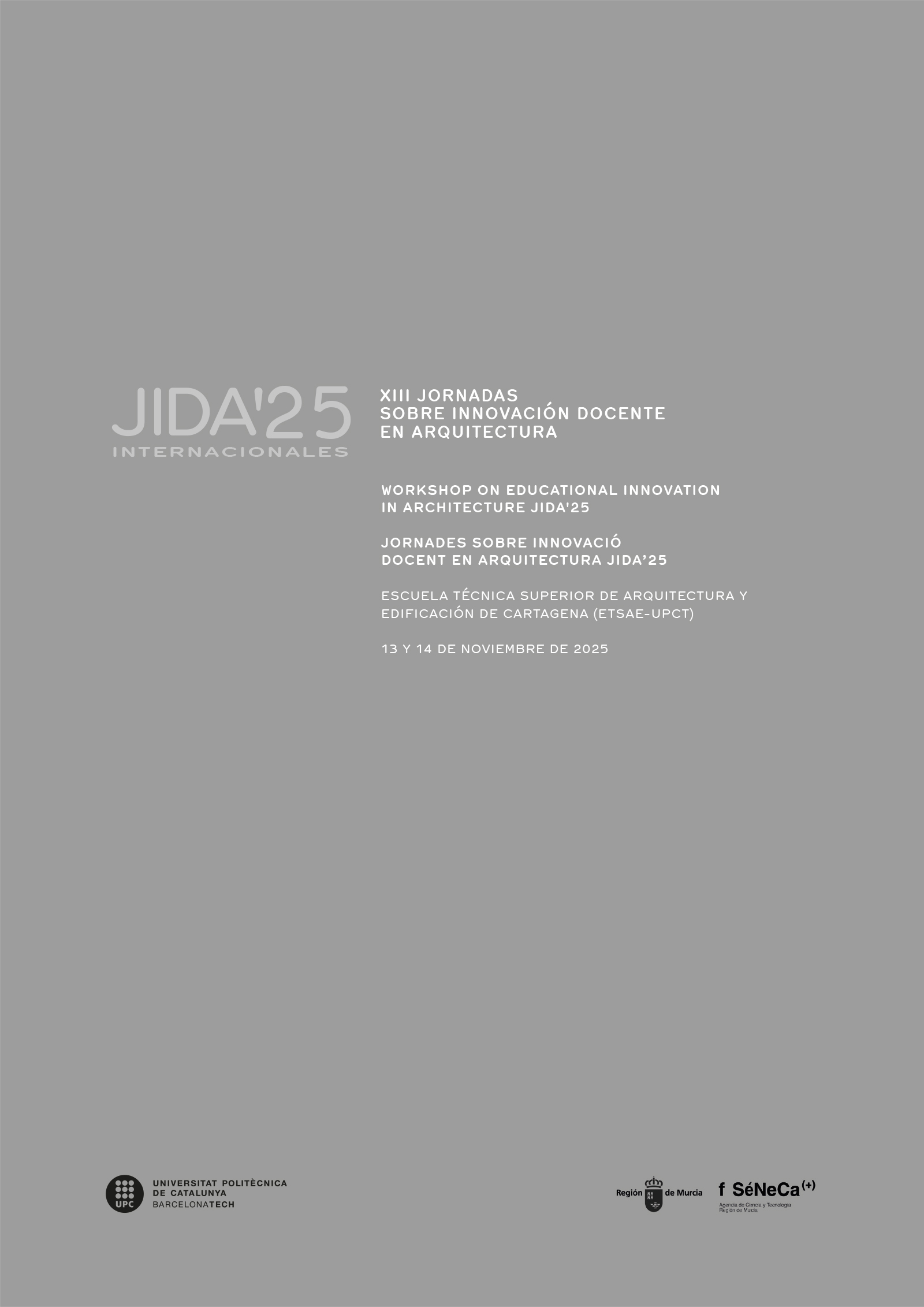Resilient housing: evolutionary strategies in the face of change and uncertainty
DOI:
https://doi.org/10.5821/jida.2025.13560Keywords:
resilient housing, indeterminacy, raw space, slack space, freespaceAbstract
In a global context framed by instability and uncertainty, resilience has emerged as a critical concept in fostering the sustainable development of socio-spatial systems. This article presents a pedagogical innovation based on the analysis and comparison of nine case studies of resilient housing through a research by design methodology. The primary objective was to identify, through deductive reasoning, the resilient characteristics in the proposed housing projects. This research contributes to the expansion and advancement of the theoretical framework of resilient architecture by addressing the planning of spatial indeterminacy. Across the nine case studies, students identified three categories of indeterminate space that develop the resilient properties of persistence, adaptation, and transformation: raw space, slack space, and freespace. Indeterminate spaces enable inhabitants to self-organize and modify their dwellings according to their aspirations over time.
References
Amirzadeh, Melika, Saeideh, Sobhaninia y Ayyoob, Sharifi. 2022. «Urban resilience: A vague or an evolutionary concept?» Sustainable Cities and Society, 81: 103853. https://doi.org/10.1016/j.scs.2022.103853
Arefi, Mahyar. 2011. «Design for resilient cities – Reflections from a studio». En Companion to Urban Design, editado por Tridib Banerjee y Anastasia Loukaitou‑Sideris, 674‑685. London: Routledge. https://doi.org/10.4324/9780203844434
ARUP. 2015. City resilience framework. https://www.rockefellerfoundation.org/wp-content/uploads/City-Resilience-Framework-2015.pdf
Brand, Stewart. 1994. How buildings learn: what happens after they’re built. London: Penguin Books.
Breton, Fèlix. 2021. «The Cable Factory, resilient architecture in Helsinki». En Grand projects: Urban legacies of the late 20th century, coordinado por Paulo T. Pinto, Ana Brandão y Sofia S. Lopes. Lisboa: DINÂMIA’CET, 293‑305. http://hdl.handle.net/10071/23862
Breton, Fèlix. 2022. Arquitectura resiliente en el siglo XXI. Construyendo una teoría a través de ocho casos europeos. Tesis de doctorado. Universidad de Girona. http://hdl.handle.net/10803/687888
Breton, Fèlix y García-Vergara, Marisa. 2025. «Equipamientos socioculturales y sistemas arquitectónicos resilientes: la Cable Factory y Can Batlló». ACE: Architecture, City and Environment, 19 (57): 12681. https://doi.org/10.5821/ace.19.57.12681
Davoudi, Simin, Shaw, Keith, Haider, Lisa Jamila, Quinlan, Allyson, Peterson, Garry, Wilkinson, Cathy, Fünfgeld, Hartmut, McEvoy, Darryn, Porter, Libby y Davoudi, Simin. 2012. «Resilience: A bridging concept or a dead end?…» Planning Theory & Practice, 13 (2): 299‑333. https://doi.org/10.1080/14649357.2012.677124
Donin, Gianpiero. 1982. Renzo Piano: pezzo per pezzo = piece by piece: catalogo della mostra = catalogue of the exhibition. Milano: Casa del Libro.
Farrell, Yvonne y McNamara, Shelley. «Freespace Manifesto. Reading Design». 2017. https://www.readingdesign.org/freespace-manifesto
García‑Escudero, Daniel y Bardí‑Milà, Berta. 2024. «Research by Design: reflexiones en torno a la investigación arquitectónica». Palimpsesto, 27 (1): 14. http://hdl.handle.net/2117/422655
Habraken, Nicolaas John. 1961. De dragers en de mensen: Het einde van de massawoningbouw [Soportes: una alternativa al alojamiento de masas]. Amsterdam: Scheltema & Holkema.
Lacaton, Anne y Vassal, Jean‑Philippe. 2017. Actitud. Barcelona: Gustavo Gili.
Liu, Wenyi, Zhou, Jie, Li, Xiaoli, Zheng, Hao y Liu, Yaohui. 2024. «Urban resilience assessment and its spatial correlation from the multidimensional perspective: A case study of four provinces in North‑South Seismic Belt, China». Sustainable Cities and Society, 101: 105109. https://doi.org/10.1016/j.scs.2023.105109
Lyon, Christopher. 2014. «Place Systems and Social Resilience: A Framework for Understanding Place in Social Adaptation, Resilience, and Transformation». Society & Natural Resources: An International Journal, 27 (10): 1009‑1023. https://doi.org/10.1080/08941920.2014.918228
Mehmood, Abid. 2016. «Of resilient places: planning for urban resilience». European Planning Studies, 24 (2): 407‑419. https://doi.org/10.1080/09654313.2015.1082980
Montaner, Josep Maria. 2008. Sistemas arquitectónicos contemporáneos. Barcelona: Gustavo Gili.
Nozza, Carlo. 2016. «“EH, Evolutionary Building” Prototype Housing at Solomeo by R. Piano & P. Rice Engineers and Architects with Gruppo Isovibro Perugia: Architectural Study and Guidelines for Conservation and Reuse». Docomomo Journal, (54): 36‑43. https://doi.org/10.52200/54.A.TBB9DHOC
Schneider, Tatjana y Till, Jeremy. 2007. Flexible housing. Oxford: Architectural Press.
Shi, Yufang, Zhang, Tianlun y Jiang, Yufeng. 2023. «Digital economy, technological innovation and urban resilience». Sustainability, 15 (12): 9250. https://doi.org/10.3390/su15129250
Sifuentes‑Muñoz, Blanca Carolina, Acosta-Salazar, Santiago, Gil-Golobart, Yasmina y Arellano‑Ramos, Blanca. 2024. «Adaptación al cambio climático a través del diseño urbano: evaluación de microclimas en l’Eixample y La Mina, Barcelona». ACE: Architecture, City and Environment, 19 (56): 12530. https://doi.org/10.5821/ace.19.56.12530
Smithson, Alison. 1974. «How to recognise and read mat‑building: Mainstream architecture as it has developed towards the mat‑building». Architectural Design, 9: 573‑590.
Smithson, Alison y Smithson, Peter. 1957. «Cluster City, a New Shape for the Community». Architectural Design, (730): 333‑336.
Smithson, Alison y Smithson, Peter. 1974. «The Space Between». Oppositions, (4): 76‑78.
Till, Jeremy. 2009. Architecture depends. Cambridge: MIT Press.
van Eyck, Aldo. 1962. «Steps towards a Configurative Discipline». Forum, (3): 81‑94.






















